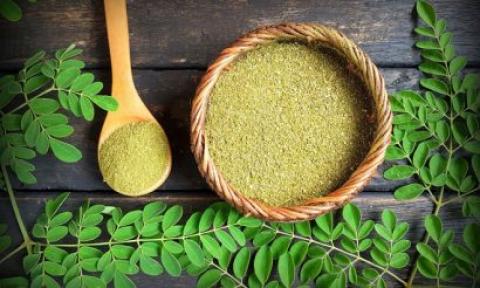Ever heard of moringa? Interested to find out? We asked Wolfgang Moritz, Head of Quality Control, Product and Quality Management at Vitarbo AG to reveal the facts behind the myth.
What is moringa?
One of those “new” foods, that you may or may not have heard about, is moringa – a dried leaf that is becoming more and more popular in our everyday diet.
Moringa is initially from north-western India and was consumed there for millennia as food. Today it grows all over the tropics, after its benefits were quickly recognised and spread around the world.
Moringa first gained recognition in Europe when the English went to India. They missed horseradish as spice for their food, and to replace it found moringa, as the taste of moringa roots resembles that of horseradish; so the plant was consequently named horseradish-tree. Another name for moringa is drumstick-tree, after the long, thin fruits of the plant that are eaten as vegetables. When a botanist looked at it, he or she originally gave it the name Moringa oleifera – “Moringa” probably based on the Tamil word for the fruit “murungai”. From the ripe seeds a good oil can be pressed – explaining the botanical name “oleifera” – the oil-bearing moringa.
“As a natural vegetarian food, moringa contains a healthy mix of nutrients…”
Though relatively new to us, moringa is no novel food and can be used as a food-ingredient in Europe but also in USA or Japan.
Great uses for moringa
Moringa has found its way into many different recipes. It can be used like a herb – as a wonderful hot or cold tea, with a full flavour, rich in antioxidants and without caffeine. Vegetable-smoothies and soups further benefit from moringa, as it adds a unique colour and a spicy taste. Moringa can also be used in salad-dressings and even bakery products. Vegetarian cereal bars are also an interesting product.
So what are the benefits?
Moringa has a slightly sharp and green taste. By drying it, the nutrients are concentrated by a factor of 4, so that in recipes, small quantities can add significant amounts of nutrients to a food. Nutrient-dense ingredients are wanted in times where processing and refining of foods have often brought tasty but nutrient-poor diets. As a natural vegetarian food, moringa contains a healthy mix of nutrients.
In the table below, some of the most relevant nutrients of moringa are shown. (Source: Vitarbo AG)
|
Element |
Unit |
100 g Leaf powder |
% of recommended daily allowance in a 6 g portion |
|
Calcium |
mg/100g |
2000 |
15% |
|
Mangan |
mg/100g |
8 |
24% |
|
Vitamine E |
mg/100g |
65 |
33% |
|
Folic acid |
µg/100g |
600 |
18% |
|
β-Carotene |
mg/100g |
20 |
25% |
Nutritionists around the world recognise that a diet rich in fruits and vegetables contributes to a healthy lifestyle. 6 g of dried moringa leaf powder (the typical consumption amount) can be produced from a good handful of fresh leaves thus contributing to a wholesome diet in a convenient way. Though drying will lead to a loss in some nutrients and fresh products are key to balanced nutrition, the leaf-powder is still a very valuable food.
What makes it a healthy product?
Besides the classic nutrients such as proteins, minerals and vitamins, moringa also contains several groups of secondary plant metabolites that are studied for their positive effects. Moringa also contains glucosinolates, that give it its slightly sharp taste. These substances are also found in watercress or mustard and are researched for their protecting effect. Moringa also has a wide spectrum of polyphenols of the groups of flavonoids and phenolic acids. Polyphenols are the substances that give tea its astringent taste and brown colour. Like tea, moringa gets its high antioxidant activity from these polyphenols. Research points to antioxidants as an important element in lowering inflammations, stabilise blood sugar and lower oxidative stress. The third major group of secondary plant metabolites are carotenoids, most prominent here are lutein and β-carotene. Carotenes are further antioxidants and support healthy vision.
The big picture
Finally, moringa has further positive benefits beyond nutrition. Today, moringa is grown by specialist producers all over the world. Most of these producers are relatively small and use manual labour to produce the best quality moringa, frequently sold on local markets. Development-organisations help promoting the benefits of moringa -even the FAO supports moringa. Its sale in Europe offers an important source of income to farmers in producing countries. The cooperation between producers and users also helps raise the quality of the products. Finally, as a plant that is specialised to grow on poor soils in dry, hot climate, moringa can help to regenerate depleted soils and thereby has an excellent ecological value.
Summing it up
With its unique taste, rich in a complex mixture of nutrients that are in this way unique, moringa has many applications and can be used in many delicious recipes. Adding it to your products will enrich nutrition and contribute to healthy lifestyle.


Spread the word